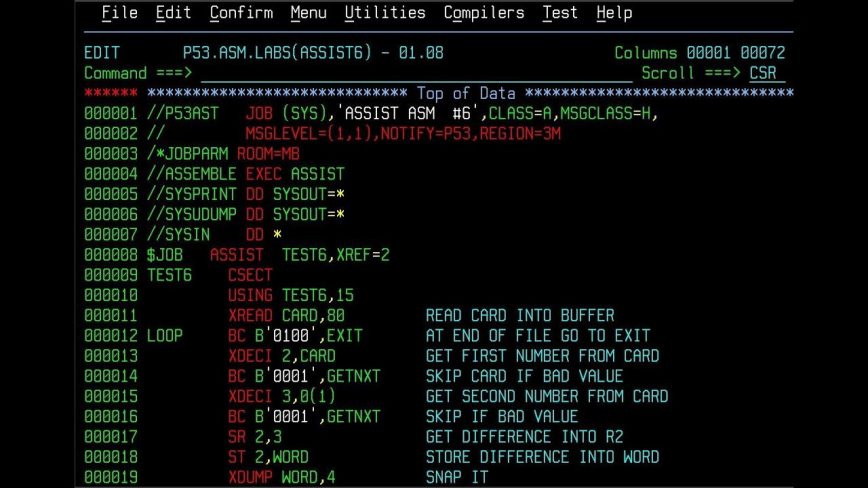What is assembler with example – As technology continues to evolve, computer programming languages have become more sophisticated, enabling developers to create complex applications. However, at the core of these languages lies the assembly language and its faithful companion, the assembler. In this article, we will explore what an assembler is, how it works, and its significance in programming. We will also provide a practical example to help you grasp the concept more effectively.
1. Introduction
Definition of an Assembler
An assembler is a software tool used in computer programming to convert assembly language code into machine language instructions that can be directly executed by a computer’s central processing unit (CPU). It acts as a bridge between the human-readable assembly code and the computer’s binary language.
Importance of Assemblers in Programming
Assemblers play a crucial role in programming as they simplify the process of writing code by allowing programmers to use mnemonics and symbols instead of dealing directly with the complex binary instructions of a computer. They also provide a layer of abstraction that makes it easier to program at a lower level.
2. How Assemblers Work
Assemblers work by translating assembly language code, which is a more human-readable form of programming, into machine language instructions. Let’s understand the process of assembling and the difference between assembly language and machine language.
Process of Assembling
When an assembler processes the assembly code, it goes through several stages. It reads the source code, analyzes the syntax and semantics, and generates the corresponding machine code. The resulting machine code is typically stored in an object file, which can be further linked with other object files to create an executable program.
Assembly Language vs. Machine Language
Assembly language is a low-level programming language that uses mnemonic codes and symbols to represent individual machine instructions. It is specific to a particular computer architecture and provides a more human-readable alternative to machine language. On the other hand, a machine language consists of binary instructions directly understood by the computer’s CPU.
3. Benefits of Using an Assembler
Assemblers offer several advantages to programmers, making them an essential tool in the software development process. Let’s explore some of these benefits.
Faster Development Process
By using assemblers, programmers can write code more quickly compared to other low-level programming languages. Assembly language instructions are closer to the hardware, enabling fine-grained control over the computer’s resources.
Increased Efficiency and Performance
Assemblers allow programmers to optimize their code for maximum efficiency and performance. By directly manipulating the hardware at a lower level, developers can take advantage of specific features of the target architecture, resulting in faster and more efficient programs.
Improved Code Readability and Maintainability
Assembly language code, when properly structured and documented, can be more readable and maintainable compared to machine language code. The use of mnemonic instructions and meaningful symbols makes it easier for programmers to understand and modify the code in the future.
4. Example of an Assembler in Action
To illustrate the concept of an assembler, let’s consider a simple example that demonstrates the process of assembling assembly code into machine language instructions.
Basic Assembly Language Instructions
Assembly language instructions are composed of mnemonic codes and operands. Mnemonics represent specific operations, while operands provide additional information required by the instruction. For example, the instruction MOV AX, 5 moves the value 5 into the AX register.
Assembly Code for Adding Two Numbers
Suppose we have two numbers stored in memory locations A and B, and we want to add them together and store the result in memory location C. Here’s an example of assembly code that accomplishes this task:

When the assembler processes this code, it translates each instruction into the corresponding machine language instructions that the computer can execute.
5. Popular Assemblers
There are various assemblers available, each catering to specific platforms and architectures. Here are a few popular ones:
NASM (Netwide Assembler)
NASM is a widely used assembler for x86 and x86-64 architectures. It supports a variety of output file formats and provides powerful macro capabilities.
GAS (GNU Assembler)
GAS, part of the GNU Compiler Collection (GCC), is another commonly used assembler. It supports multiple architectures, including x86, ARM, MIPS, and PowerPC.
MASM (Microsoft Macro Assembler)
MASM is an assembler provided by Microsoft for x86-based systems. It offers a rich set of features and is often used in Windows development.
6. Tips for Writing Efficient Assembly Code
To optimize the performance and efficiency of your assembly code, consider the following tips:
Optimize Register Usage
Make efficient use of registers to minimize memory access and improve execution speed. Use registers for temporary storage and frequently accessed variables.
Minimize Memory Access
Reducing memory access is crucial for performance. Accessing data from memory is slower compared to registers. Utilize caching techniques and minimize unnecessary memory operations.
Use Conditional Jumps Judiciously
Conditional jumps can impact code execution speed. Use them judiciously and avoid unnecessary branching to maintain optimal performance.
7. Common Challenges and Best Practices
While working with assembly language and assemblers, programmers may encounter some challenges. Here are a few common ones along with best practices to overcome them:
Debugging Assembly Code
Debugging assembly code can be challenging due to its low-level nature. Utilize debugging tools specifically designed for assembly language and make use of step-by-step execution and register monitoring.
Code Portability and Compatibility
Assembly code is often platform-specific, limiting its portability. Consider using platform-agnostic assembly constructs and techniques to improve code portability and compatibility across different systems.
Documentation and Commenting
As with any code, documentation and commenting are essential for understanding and maintaining assembly code. Provide clear and concise explanations for each section of the code, along with comments to clarify its functionality and purpose.
8. Conclusion
In conclusion, an assembler is a vital tool in computer programming that converts assembly language code into machine language instructions. It simplifies the coding process by providing a human-readable representation of low-level instructions. Assemblers offer numerous benefits, including faster development, increased efficiency, and improved code readability and maintainability.
By understanding how assemblers work and following best practices, programmers can write efficient assembly code. Optimal register usage, minimizing memory access, and judicious use of conditional jumps contribute to better performance. Additionally, debugging assembly code, ensuring code portability, and providing comprehensive documentation are essential for successful development.
Assemblers like NASM, GAS, and MASM are popular choices for different architectures and platforms, catering to specific programming requirements. They empower programmers to harness the full potential of the underlying hardware.
In conclusion, assemblers continue to play a crucial role in programming, enabling developers to write efficient and optimized code at a low level. Understanding their importance and mastering their usage can greatly enhance the development process and result in high-performance applications.
9. FAQs
1. Can assembly language be used for all types of programming tasks?
Assembly language is primarily used for low-level programming tasks, such as device drivers, operating systems, and embedded systems. However, it is not suitable for all types of programming tasks, especially those that require high-level abstractions and rapid development.
2. Is learning assembly language necessary for modern programmers?
While learning assembly language is not a requirement for all programmers, it can provide valuable insights into how computers and processors work at a fundamental level. It can also be beneficial for optimization purposes and understanding low-level interactions in specific domains.
3. Are assemblers platform-specific?
Yes, assemblers are typically platform-specific, as they are designed to work with specific architectures and instruction sets. Different platforms may require different assemblers tailored to their specific hardware.
4. Can assembly language code be mixed with high-level programming languages?
Yes, it is possible to combine assembly language code with high-level programming languages. This approach, often referred to as “inline assembly,” allows programmers to harness the efficiency and low-level control of assembly code within a higher-level language program.
5. How can I get started with learning assembly language?
To get started with learning assembly language, you can find online tutorials, books, and resources specifically designed for beginners. Experimenting with simple programs and gradually increasing their complexity will help you grasp the concepts effectively.
Now that you have a solid understanding of assemblers and their role in programming, you can explore the fascinating world of low-level coding and unleash the power of assembly language in your projects.
Remember, practice and experimentation are key to mastering any programming language, and assembly language is no exception. Happy coding!
Avail 50% Discount on our Shared BDIX Hosting Products
Promo Code – 50BDIX
Link: BDIX Shared Hosting
com Domain Registration | Buy a .com Domain Name Today
Search The Domain Name You Want com Domain Registration – The internet has become an
-
Best Ransomware Detection Techniques
22 May 2023 -
What is Drupal used for?
22 May 2023 -
Is PrestaShop a CMS or Framework?
22 May 2023







